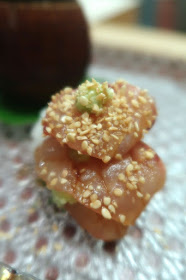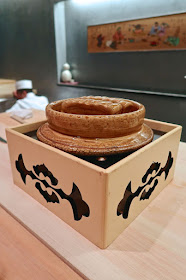One of Thailand's national dishes, Pad Thai is a simple and delicious stir-fried noodle dish enjoyed throughout Thailand, one of the most popular and loved cuisines in the world. Showcasing the classic harmony of Thai flavours: sweet, sour and salty, this sensational recipe embodies the culinary spirit of Thailand, made with soaked dried rice noodles, which are stir-fried with eggs, chopped extra-firm tofu, plenty of plump prawns and flavored with tamarind pulp, fish sauce, garlic, shallots, palm sugar, and garnished with lime wedges, fresh hot red chilis and chopped roast peanuts. Inspired by some of the delicious Pad Thai we enjoyed while in Bangkok, Chaing Mai and Koh Samui, this recipe shows how the flavours and textures of premium quality ingredients come together into one amazingly delicious dish.
Pad Thai with Shrimp, Tofu and Organic Bean Sprouts
Serves 2
4 oz wide flat Thai rice stick noodles, about 1/4 package
4 tbsp fish sauce
2 tbsp tamarind paste
3 tbsp palm sugar
1/8 tsp chilli powder, to taste
4 tbsp vegetable oil
1 large shallot, finely chopped
2 cloves of garlic, finely chopped
4 oz extra-firm tofu, chopped into 1/2-inch cubes
8 large prawns, peeled and deveined
2 large eggs, ready cracked
4 cups organic beansprouts
1/2 cup chopped cilantro, plus extra for garnish
4 green onions, green part only, cut into 2-inch diagonal pieces
1 cup roasted peanuts, roughly chopped
2 limes, cut into wedges for garnish
2 fresh red chilis, seeded and sliced on a diagonal, optional
Soak the rice noodles in cold water for 1-2 hours, then drain. Meanwhile, make the sauce by combining the fish sauce, tamarind and palm sugar in a small pan or medium heat, stirring gently to dissolve the sugar. Season with chilli to taste and set aside.
Lay out all the ingredients within easy reach of the hob in the order they'll be used. Put a wok on a high heat and add half the oil. Add the garlic and shallot and stir constantly for two minutes. Then add the shrimp and tofu and stir fry until the shrimp begin to change colour, about 30 seconds. Add the eggs to the pan and using a wooden spoon, pierce the yolks and gently move the eggs around the pan until almost cooked. Then place across the pan the drained noodles and gently stir fry until they become slightly limp, then add the sauce and stir fry until they are just tender and evenly coated with the sauce, about 3-4 minutes. Add the chopped green onions, two tablespoons of the chopped peanuts and cook, tossing, until they are mixed in and barely heated, about 30 seconds. Test a noodle for doneness, then add the cilantro and toss well to combine. The noodles should taste sweet, sour and salty.
To serve, transfer the noodles to a large platter, leaving space for a mound of bean sprouts next to the Pad Thai, then top with the reserved lime wedges. Garnish the noodles with the remaining chopped peanuts, cilantro and sliced red chilis, and serve immediately.


















































































